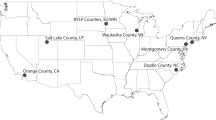Abstract
To describe and evaluate recruitment techniques used to enroll 152 healthy pregnant women fewer than 15 weeks gestation into a prospective study of environmental chemical exposure during pregnancy. Posters, a website, online and print advertising, recruitment emails, media coverage, recruitment from clinic waiting rooms, networking within the pregnancy community and presenting a study booth at baby “trade shows” were used to advertise the study. Participants had to meet a strict set of eligibility criteria, and were asked to donate two-second-trimester blood samples, complete two questionnaires, have samples of air, dust, lint and tap water collected from their homes, and donate a cord blood sample at delivery. Over 17 months, 171 women enrolled (49% of initial contacts, and 99% of all eligible women) and 152 women completed the study (89% retention). Total recruitment costs were approximately $400 Cdn per final participant. Posters, study booth presentations and online advertising generated the most inquiries about the study. Word of mouth, referral from another study and direct email were the most cost-effective strategies. Not surprisingly, the recruited study population was less ethnically diverse, more affluent and more educated than the background population of pregnant women in Vancouver. A combination of passive and active recruitment techniques were successful for recruiting healthy women in roughly the first trimester of pregnancy (<15 weeks gestation). While a convenience sample of women is suitable for our study questions, additional strategies may be required to recruit a more representative pregnant population in future studies.


Similar content being viewed by others
References
CHILD study. Canadian Healthy Infant Longitudinal Development (CHILD) study (www.canadianchildstudy.ca).
National Children’s Study. (www.nationalchildrensstudy.gov).
Surks, M. I. (2006). Drug interactions with thyroid hormones. In D. S. Basow (Ed.), UpToDate. MA: Waltham.
Statistics Canada. 2006 Community Profiles. 2006 Census. Statistics Canada Catalogue no. 92-591-XWE. Ottawa. Released March 13 2007. http://www12.statcan.ca/census-recensement/2006/dp-pd/prof/92-591/index.cfm?Lang=E.: Statistics Canada, 2007.
BCPHP. British Columbia Perinatal Database Registry Annual Report. Vancouver, BC Canada. www.bcphp.ca/AnnualReport.htm. Accessed May 5, 2009. 2007.
Golding, J., & Birmingham, K. (2009). Enrollment and response rates in a longitudinal birth cohort. Paediatric and Perinatal Epidemiology, 23(Suppl 1), 73–85.
Savitz, D. A., Dole, N., Williams, J., et al. (1999). Determinants of participation in an epidemiological study of preterm delivery. Paediatric and Perinatal Epidemiology, 13, 114–125.
Handler, A., Rosenberg, D., Johnson, T., et al. (1997). Prospective recruitment of women receiving prenatal care from diverse provider arrangements: A potential strategy. Maternal and Child Health Journal, 1, 173–177.
Richiardi, L., Baussano, I., Vizzini, L., et al. (2007). Feasibility of recruiting a birth cohort through the Internet: The experience of the NINFEA cohort. European Journal of Epidemiology, 22, 831–837.
Buck, G. M., Lynch, C. D., Stanford, J. B., Sweeney, A. M., Schieve, L. A., Rockett, J. C., et al. (2004). Prospective pregnancy study designs for assessing reproductive and developmental toxicants. Environmental Health Perspectives, 112(1), 79–86.
Harris, M. A., Levy, A. R., & Teschke, K. E. (2008). Personal privacy and public health: Potential impacts of privacy legislation on health research in Canada. Canadian Journal of Public Health, 99, 293–296.
Wallace, R. B. (2008). Maxcy-Rosenau-Last public health & preventive medicine. Toronto: McGraw-Hill.
Gordis, L. (2004). Epidemiology. Philadelphia: Elsevier/Saunders.
BCPHP. British Columbia Perinatal Database. Vancouver, BC, Canada: British Columbia Perinatal Health Program. www.bcphp.ca/PerinatalDatabaseRegistry.htm. (Data abstracted Sept 9, 2009, 2007).
Acknowledgments
We thank Health Canada, the BC Medical Services Foundation, the BC Environmental and Occupational Health Research Network, and the UBC Centre for Health and Environment Research for research funding, and the Michael Smith Foundation for Health Research, the Natural Sciences and Engineering Research Council, and the Canadian Institutes of Health Research for supporting GMW’s work. We also thank Sara Leckie for her help with participant recruitment.
Author information
Authors and Affiliations
Corresponding author
Electronic supplementary material
Below is the link to the electronic supplementary material.
Rights and permissions
About this article
Cite this article
Webster, G.M., Teschke, K. & Janssen, P.A. Recruitment of Healthy First-Trimester Pregnant Women: Lessons From the Chemicals, Health & Pregnancy Study (CHirP). Matern Child Health J 16, 430–438 (2012). https://doi.org/10.1007/s10995-010-0739-8
Published:
Issue Date:
DOI: https://doi.org/10.1007/s10995-010-0739-8




